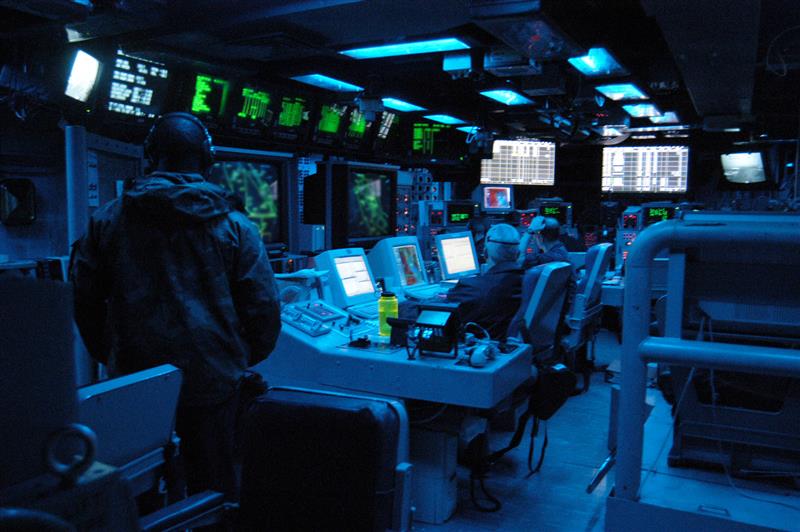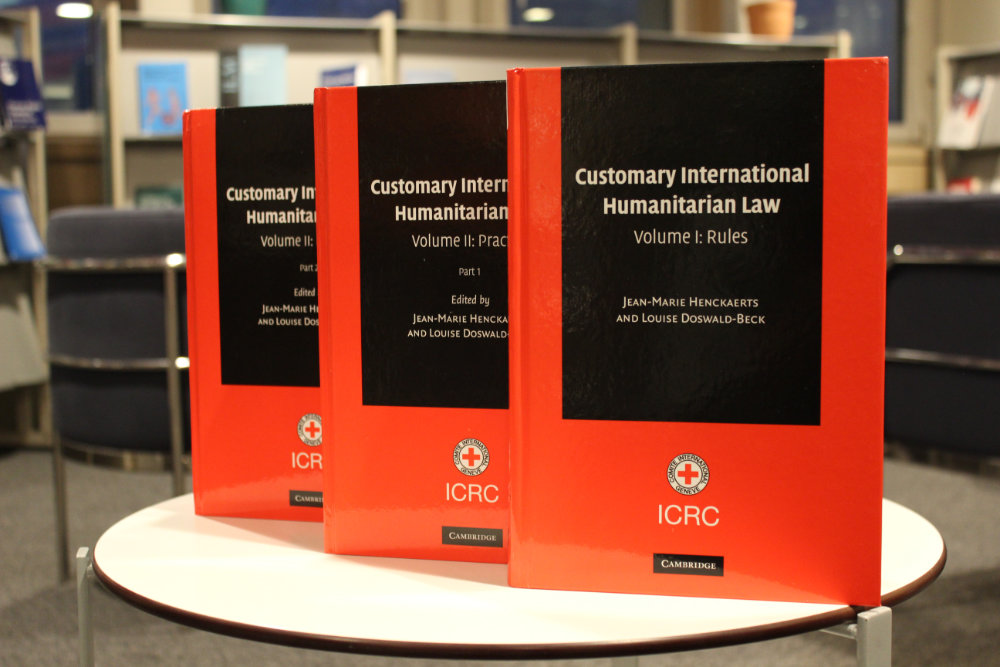In an era of rising geopolitical tensions, terms like ‘hybrid threats,’ ‘grey zones,’ and ‘proxy warfare’ are frequently used to describe covert and ambiguous operations, suggesting they blur the lines between peace and armed conflict. From cyberattacks on civilian infrastructure to the damaging of undersea cables, these acts are often labeled as ‘hybrid warfare,’ raising questions about their legal and political implications.
In this post, and drawing from the ICRC’s 2024 report on contemporary challenges to international humanitarian law (IHL), ICRC Legal Advisers Samit D’Cunha, Tristan Ferraro, and Tilman Rodenhäuser clarify how legal criteria – not political narratives – determine whether a situation constitutes an armed conflict, highlighting the importance of accurate classification to uphold the protections afforded by IHL.
In the last few months, suspicious fires in warehouses and aboard aircraft, the severing of undersea power and Internet cables, GPS jamming, cyber operations against critical civilian infrastructure, and allegations of influence operations and election interference have been depicted as ‘hybrid warfare’ by both politicians and the media. So-called ‘hybrid threats’ or ‘hybrid attacks’, as well as allegations of the use of proxies to project power while attempting to obfuscate attribution and legal as well as political responsibility are a symptom of worrying developments, in particular in Europe. The geopolitical environment today is characterized by increasing/ed tensions among states, a militarized security environment, instability within countries, projection of power through a range of covert and coercive measures, and – at the global level – an increasing number of armed conflicts.
While neither ‘hybrid’ threats or warfare, nor the notion of proxies, are defined in international law, the use of such terms is often accompanied by the suggestion that certain acts are taking place in a ‘grey zone’. The term ‘grey zone’, in turn, appears to suggest that the line between armed conflict and peace is blurring, or that the law is unclear or non-existent in certain of these situations. However, while some of these types of operations are old and others are new, international law always applies. And more specifically regarding international humanitarian law (IHL), determining whether a specific situation amounts to armed conflict remains an assessment of facts based on well-established legal criteria derived from the four Geneva Conventions as well as their Additional Protocols.
This post explores when ‘hybrid attacks’ or ‘proxy warfare’ might amount to an armed conflict as defined in IHL. It presents an excerpt of the ICRC’s 2024 report on ‘International Humanitarian Law and the Challenges of Contemporary Armed Conflict’.
‘Competition’, ‘hybrid warfare’, and ‘proxies’ – tentative definitions of ambiguous concepts
In common usage, the term ‘competition’ is often employed to describe rivalry between states at the political, economic, and military levels.
‘Hybrid threats’ or ‘hybrid warfare’ are terms commonly used to describe the employment of a combination of different technologies or other means by a state or non-state actor to project power to destabilize adversaries. Acts described as ‘hybrid’ include military and non-military acts, as well as operations that are covert or overt, kinetic or non-kinetic (for example, disinformation or cyber operations), lethal or non-lethal. The term may refer to operations affecting a state’s military, its government, or its civilian population or infrastructure, and is used to describe operations often conducted by a combination of state and non-state actors.
‘Proxy warfare’ is a term used to refer to armed hostilities involving entities (both state and non-state actors) that other states or non-state actors may support directly or indirectly – politically, materially, financially, militarily or otherwise – in line with their own strategic interests against another state or non-state actor.
Speaking law to politics
The definition of what is an armed conflict to which IHL applies has not changed. States and other actors must assess each situation of armed violence from a legal perspective to determine whether their operations constitute an armed conflict or form part of a pre-existing one. For example, relying on widely established legal criteria, the ICRC has assessed that in 2024 there are more than 120 armed conflicts around the world, involving more than 60 different states and 120 non-state armed groups as parties to those conflicts.
The significance of the determination whether a situation amounts to an armed conflict is first and foremost legal. While parties involved may or may not consider themselves belligerents for a variety of reasons, as a matter of law they have become parties to an armed conflict and therefore must comply with IHL.
Under IHL, armed conflicts are either international or non-international in nature. International armed conflicts are those armed conflicts in which two or more states are opposed. Article 2 common to the four Geneva Conventions of 1949 (common Article 2) states that the Conventions “shall apply to all cases of declared war or of any other armed conflict which may arise between two or more of the High Contracting Parties, even if the state of war is not recognized by one of them”. Accordingly, any difference arising between two or more states leading to a resort to armed force is an armed conflict within the meaning of common Article 2. Therefore, when a situation objectively shows that, for example, a state is involved in military operations or any other hostile actions against another state (by attacking or capturing enemy military personnel or assets, hampering its military operations, or using or controlling its territory without its consent), the situation is an international armed conflict. It makes no difference how long the conflict lasts, how much slaughter takes place or how numerous the participating forces are. This means that there is no specific level of intensity of hostilities required for international armed conflicts, in contrast to non-international armed conflicts.
Non-international armed conflicts are armed conflicts between a state and a non-state armed group, or between such groups. They require two conditions to be met for IHL to apply: the non-state party or parties must be organized; and the violence between the parties must be sufficiently intense.
In the classification of armed conflicts, any assessment must be made objectively and exclusively on the basis of the facts on the ground. In that sense, new factual scenarios or narratives do not necessitate devising novel, ad hoc, or additional legal criteria to establish whether such situations amount – or not – to armed conflict. Thus, under IHL, notions such as ‘competition’, ‘hybrid threats’ or ‘hybrid warfare’, or ‘proxy warfare’, must be assessed based on the existing criteria.
For instance, a relationship between states that is described as ‘competition’ may or may not amount to an armed conflict, depending on whether it escalates into a resort to armed force between these states.
Similarly, an act described as a ‘hybrid threat’ or ‘hybrid attack’ will be governed by IHL only if it either triggers an armed conflict or occurs in the context of (and is associated with) an existing armed conflict. The latter is true even for those acts that would not, on their own, have triggered the applicability of IHL. For example, while cyber operations that are conducted in the context of an armed conflict must comply with IHL and thus, for instance, not be directed against medical facilities, not all cyber operations against a medical facility in times of peace will be the starting point of an armed conflict. Likewise, the prohibition of acts or threats of violence the primary purpose of which is to spread terror among the civilian population applies to influence operations if carried out in the context of an armed conflict, even if these operations in and of themselves would not trigger the applicability of IHL if conducted in times of peace. In situations in which acts described as ‘hybrid warfare’ neither trigger an armed conflict nor occur in the context of an armed conflict, these acts are regulated by peacetime rules only and not by IHL.
Uses of proxies by states can and must also be analysed on the basis of existing legal criteria. For example, the classification of an armed conflict between a state A that controls a proxy and a state B fighting against that proxy will depend on the degree of control that state A has over its proxy. In order for the conflict to qualify as an international armed conflict between states A and B, the proxy’s acts must be legally attributable to state A. With regard to non-state armed groups acting as proxies, when one state exercises ‘overall control’ over an armed group fighting against another state, the situation is classified as an international armed conflict between the two states (for detail, see here paras 298-306). Regardless of the political characterization of a situation as a ‘proxy war’, in this case the ‘overall control’ test (which, strictly speaking, is used to determine whether a non-state armed group is a de facto organ of a state) is the legal test to determine whether the hostile acts of the proxy against an enemy state can be attributed to the controlling state and thus trigger an international armed conflict opposing these two states.
Conclusion
In situations of tension, how we describe or qualify incidents is important. Calling situations ‘war’ or ‘warfare’ when they do not, in fact, amount to armed conflict risks adding fuel to the fire. To avoid potentially dangerous misunderstandings, international law provides a coherent and decisive framework to assess facts. As shown in this post, the political narratives surrounding ‘competition’, ‘hybrid attacks, ‘proxy warfare’ or other ‘grey zone’ terminology must not obfuscate or displace the legal classification of armed conflicts and the application of IHL. The legal classification of such situations requires disentangling the facts on the ground and applying the law to these facts. While this might sometimes be complicated because of the difficulty of obtaining clear information, that is a factual difficulty, not a legal one. Activities such as the imposition of economic measures, information operations, election meddling, and espionage, by themselves, do not trigger an armed conflict.
Editor’s note: This post was originally published on EJIL:Talk! on 15 January 2025 and is available here.
See also:
- Cordula Droege, Championing IHL compliance in contemporary armed conflict: the 2024 ICRC Challenges Report, October 9, 2024
- Cordula Droege, War and what we make of the law, July 18, 2024
- Samit D’Cunha, Tristan Ferraro, Thomas de Saint Maurice, Defining armed conflict: some clarity in the fog of war, May 2, 2024







